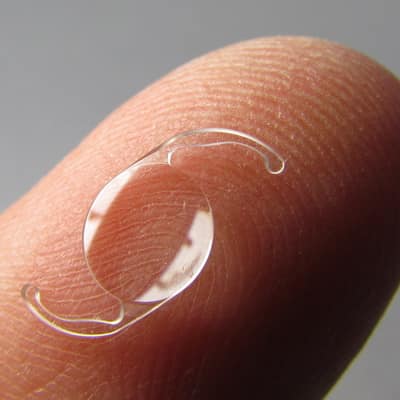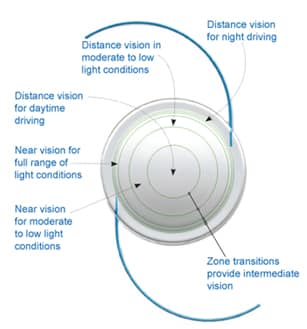Lens Options
There are different types of artificial lenses that can be used during cataract surgery. The type of lens you receive will be based on your individual vision needs.
Intraocular Lenses (IOL's)
An intraocular lens is placed in the eye after your natural lens has become opaque as a result of removing a cataract, to restore your eyesight to normal. The type of intraocular lenses, known as IOLs, has also undergone significant development with advancements in surgical technology for cataract surgery.
The choice of IOL will be based on several factors, including your lifestyle and visual needs. Your ophthalmologist will discuss with you which type of IOL is best suited for you.
Intraocular lenses were only deemed “safe and effective” by the US Food and Drug Administration in 1981. The sorts of lenses that are now accessible for cataract surgery have been nothing short of a revolution throughout this time.
Book Free Consultation
Book Appointment or Video Consultation online with top eye doctors

Types of Intraocular Lenses (IOLs)
- Anterior Chamber Lenses (ACIOL): These lenses are placed on top of the iris, the brown portion of the eye. It is not in the natural lens’s physiological position, and this type of lens is not as effective as other types after non-complicated cataract surgery. In case the posterior capsule of the lens is deficient or damaged, ACIOLs are inserted.
- Posterior Chamber Lenses (PCIOL): These lenses are located in the natural lens’s physiological position behind the residual posterior capsule and are the most common type of contact lenses. If the cataract is removed using phacoemulsification, then a PCIOL is inserted.
Types of Premium IOLs
The only way to repair cataracts is with surgery, where your natural lens is removed. A synthetic replacement lens (IOL) or prosthetic lens takes its place, performing the same task as the lost natural lens.
IOLs are of different types, and the type that is best for you will be determined by your surgeon, depending on various factors such as your eye condition, expected visual outcome and your lifestyle. Here we take a look at the main types of premium IOLs available:
- Monofocal Lenses
- Multifocal Lenses
- Toric Lenses

Monofocal Lenses
A monofocal lens, unlike the natural lens of the eye, can only restore distance or close vision. The strength of a monofocal lens is usually determined so that the patient does not require reading glasses or bifocals for distant viewing. You will need reading glasses or even bifocals if you have had a monofocal lens implantation because your preexisting refractive error (particularly astigmatism) necessitates modifications in power. The following are some of the many types of monofocal lenses:
- Aurium (Monofocal): Medennium (US) produces monofocal Aurium lenses. These lenses are photochromatic, which means they become a little tinted during the day or in bright light and so protect you from UV rays. Under normal room lighting, these lenses turn transparent.
- Acrysof IQ (Monofocal): Acrysof IQ is an imported monofocal lens manufactured by Alcon (USA). These lenses provide clear distance vision. However, a person may require additional reading glasses for near vision. This lens has a yellow pigment chromatophore that blocks harmful UV rays and blue light from entering the eye and damaging the retina.
- Aurovue(Monofocal): Aurolab is an Indian firm that creates Aurovue lenses. These lenses are considered as low-budget alternatives for cataract surgery and are suited for individuals on a tight budget.
- Akreos AO(Monofocal): The AKREOS AO are comparable to Aurovue lenses. These, however, are imported lenses produced by Bausch & Lomb (USA).
- Acrysof SP(Monofocal): The Alcon Acrysof SP is a monofocal lens manufactured in the United States by Alcon (USA). These lenses are also popular among diabetics. It’s also an excellent choice for people who want a monofocal lens after phacoemulsification.
Multifocal Lenses
Multifocal IOLs are lenses that provide near and distance vision restoration comparable to monofocal IOLs. When selecting an IOL, keep in mind that multifocal lenses offer freedom from glasses for both close and distant viewing and can be tailored to your active lifestyle. However, your doctor will discuss the apparent drawbacks of these lenses, such as glare and decreased contrast sensitivity, with you. If you do not want to wear glasses for near or far distances and do not want to pay the extra cost of a multifocal IOL, your doctor will talk about monovision with you. The following are the best multifocal lenses:
- Tecnis Symphony (Multifocal): The Tecnis Symphony is a multifocal lens from Abott (USA). This lens offers excellent distance and intermediate vision on computers.
- Zeiss Trifocal (Multifocal): The lenses produced by Zeiss (USA) are called trifocal Zeiss trifocal lenses. These are the only ones that provide good vision for near, intermediate, and long distances.
- iDiff (Multifocal): Care Group’s iDif lenses are multifocal contact lenses. These contacts provide clear vision for near and distance, allowing a person to conduct basic daily activities like reading and writing without the necessity of additional glasses. iDiff Lenses, on the other hand, do not correct intermediate vision.
- Tridiff (Multifocal): Care Group Tridiff lenses are multifocal contacts. These lenses enable a person to easily carry out basic day-to-day tasks, such as working on the laptop and performing intermediate distance activities like reading and writing without requiring the assistance of additional equipment.
- Alcon Pantopix (Multifocal): It’s the biggest introduction in multi-focal lenses. The lens is capable of delivering great distant, immediate, and close vision.
Toric Lenses
The power of the eye can be divided into two categories: spherical power, which is inherent to the natural lens inside the eye, and cylinder power, which comes from the corneal curvature’s unevenness. Monofocal and multifocal lenses may only correct part of the spherical component of an eye, leaving residual cylinder power that must be addressed with additional prescription glasses. Toric contact lenses are advised if you have a high degree of pre-existing astigmatism or cylinder in your eyes. The following are some suggested Toric contacts:
- Acrysof IQ (Toric): These lenses are intended to correct astigmatism in the days leading up to cataract surgery. Alcon (USA) is the manufacturer of this lens.
- Acrysof Toric (Toric): These lenses are identical to Acrysof IQ on the inside, with cylinder correction.
- Zeiss (Toric): The lens is made by the German company Carl Zeiss, which makes it one of the best cylinder correction lenses available.
Which is the best IOL for you?
| Lenses | Cost | Strength | Weakness |
|---|---|---|---|
| Monofocal | Standard | Cheapest option | Only has one area of focus |
| Often fully covered by insurance | Individual will likely need glasses for some tasks | ||
| Multifocal | High | Multiple points of focus | Longer adaption time |
| Patient may not need glasses | Individual may still need glasses | ||
| Toric | Increases Cost | Corrects astigmatism | Adds to cost |

